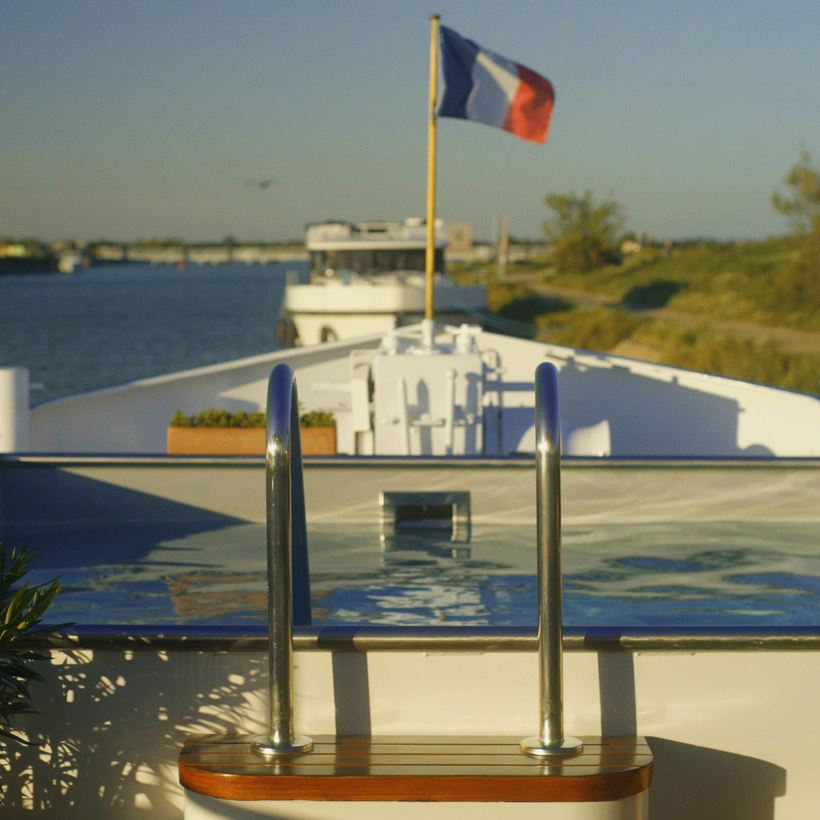When foreigners talk about the wildlife in France, they’re usually referring to Paris, or maybe St. Tropez after dark. But among the French, it’s the Camargue, the marshy, mosquito-ridden delta near Port-Saint-Louis-du-Rhône, where the Rhône River empties into the Mediterranean.
France’s equivalent of the Wild West is populated by outlaws, rebels, cowboys (known as gardians), pink flamingos, black bulls, and free-ranging white horses. Its residents tend to thumb their noses at bourgeois politesse, and truculently prefer to lead their lives with minimal government interference. Like the Mississippi Delta, it’s a good place to live off the grid or maybe even go feral.

The Camargue is an unexpected venue for a luxury vacation, but that’s what makes Belmond’s new boat trip through the region so fascinating. The LVMH-owned hospitality company is behind some of the most opulent hotels (such as Hotel Cipriani, in Venice) and trains (the Venice Simplon-Orient-Express, for starters) in the world.
It also operates seven sumptuous single-hire barges that wind through the waterways of France. Think boutique hotel rather than ocean liner—the spacious, well-lit cabins are stylishly decorated, occasionally outfitted with bathtubs and kitted out with Diptyque amenities.

Its vessel for a seven-day journey through the Camargue is Pivoine, a 150-foot barge built in Belgium in 1959. Now painted a jaunty cobalt, it has just four cabins, and in May, I embarked on a three-day version of its inaugural voyage. Upon arrival in the village of Gallican, where Pivoine was moored, I dropped off my luggage as did the three other passengers.
Its residents tend to thumb their noses at bourgeois politesse, and prefer to lead their lives with minimal government interference.
The cheerful cabin staff had set the dining table, and my fellow travelers and I were introduced to the chef, a Polish-Cypriot man named Theo Tsangaras, who most recently worked in a Warsaw hotel. I silently feared that the meals might be hospitality-school “Continental,” but I was wrong. He skillfully mastered shrimp and roasted vegetables, perfectly cooked tournedos de boeuf with asparagus, potato puree covered in a magnificent jus de viande, and a moelleux au chocolat. The wines, a Chablis grand cru and a lush Mercurey, were equally delicious.

The second day of the journey began with a very early morning of bird-watching deep in the marshes. The Camargue has more than 350 different species of sedentary and migratory birds, and mallards, teals, and tigers spend winters there. After lunch and a siesta back on the barge, we disembarked near the port of Aigues-Mortes (meaning “dead waters,” a reference to the neighboring salt marshes) for a private visit to the salt producer Salins du Midi, known for its La Baleine sea salt, which is found in cupboards around the world.

“You have to try and imagine what it was like to work here when everything was still manual,” said our French guide, a rangy man with a wry sense of humor who’d worked for the Salins for many years. “It was hot, the light was blinding, the heavy salt burned, there was no shade, and everything was done by hand. This was a brutal place to work.” There was no denying the barren beauty of the site, however, and we returned to Pivoine with a chastened appreciation of the salt on our table.
Our third day began with an unexpectedly interesting visit to an organic herb farm, where we ended up mixing a miniature batch of lavender face cream. After a lunch of chilled zucchini soup and quiche, we chugged up the Rhône to Avignon while bobbing in the plunge pool on Pivoine’s bow, drinking rosé and admiring the banks of the river.

After docking in Avignon, I went off to meet a friend at the Musée Calvet. Later in the day, we sat on the bow of Pivoine for a flute of champagne before dinner. “Avignon’s always a treat,” said one of my travel companions. “But what I liked best was the Camargue. I’d love to spend some more time there.” Who could argue with that?
The writer was a guest of a Belmond passenger. A seven-day, all-inclusive cruise for eight passengers in four cabins from Avignon to Sète through the Rhône River and the waterways of La Camargue costs $75,000
Alexander Lobrano is a Writer at Large at AIR MAIL. His latest book is the gastronomic coming-of-age story My Place at the Table: A Recipe for a Delicious Life in Paris


